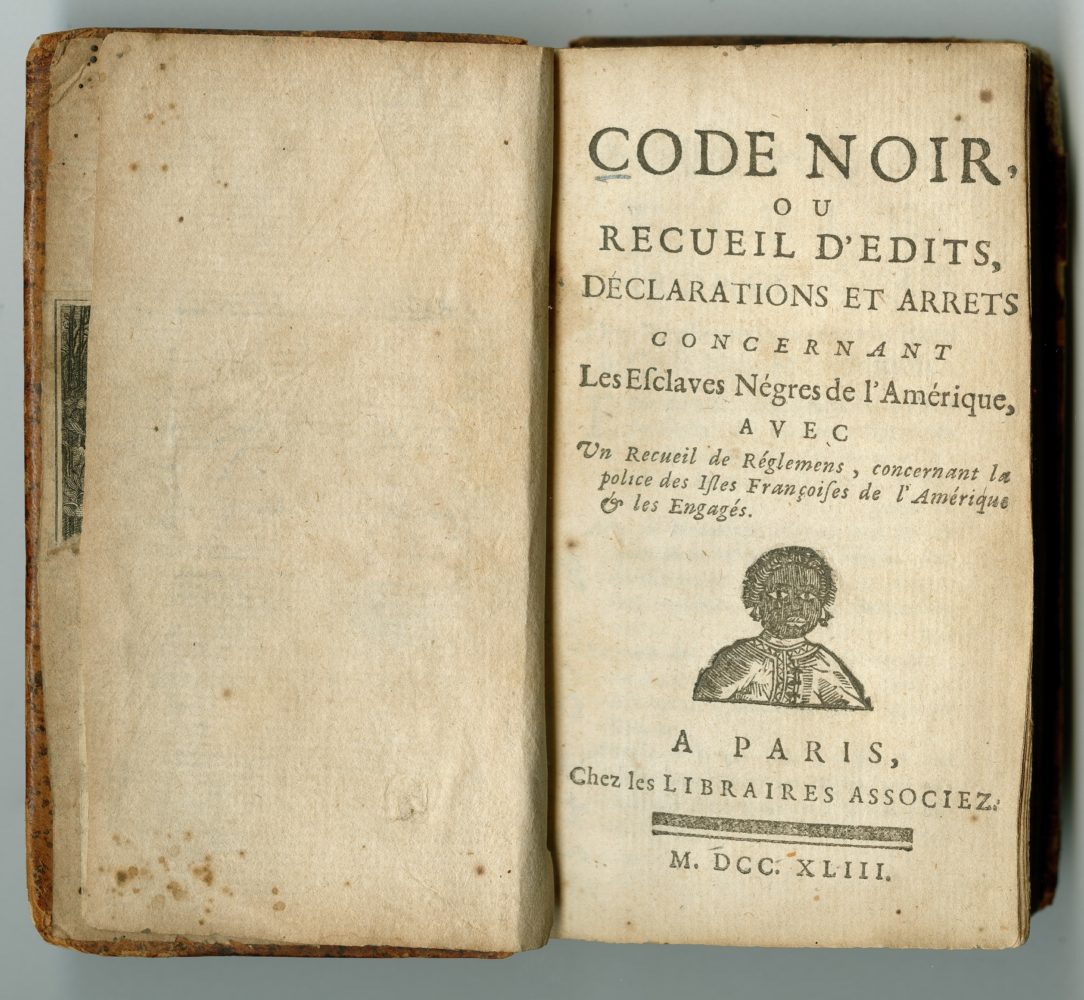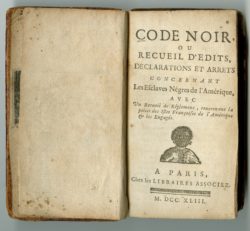Slavery in French Colonial Louisiana
As early as 1699, when Pierre Le Moyne d'Iberville first began to develop the French colony of Louisiana, he petitioned the king to allow a slaving expedition to the west coast of Africa to procure captive laborers.

The Historic New Orleans Collection
Code Noir of 1724. Paris: les Librairies Associez, 1743.
As early as 1699, when Pierre Le Moyne d’Iberville first began to develop the French colony of Louisiana, he petitioned the king to allow a slaving expedition to the west coast of Africa to procure captive laborers. Although the first cargo of enslaved Africans did not arrive in Louisiana until 1719, a census of the colony in 1708 counted eighty Indian men and women held as slaves among the total population of 278. Between 1719 and 1731, when the Company of the Indies was in charge of economic development in Louisiana, the company’s ships landed more than six thousand Africans who were sold into slavery. The French instituted the Code Noir, a set of laws that was supposed to ensure the well-being of the enslaved workers while keeping them under control, but the laws were frequently ignored by owners and enslaved people.
Slavery in Louisiana under French rule has to be viewed against general conditions in the colony. For much of the period, Louisiana struggled for survival, and it never developed into the profitable, self-sustaining colony its founders had intended. French colonial Louisiana was more a “society with slaves” than a full-fledged “slave society,” a distinction commonly used by scholars who study the history of slavery in the United States. There were few enslaved people in Louisiana before 1720. As in other New World colonies, efforts to enslave the indigenous population in Louisiana proved futile and contributed to the colonial authorities’ decision to import enslaved Africans.
The large majority of the approximately six thousand enslaved Africans imported into Louisiana during the entire French period arrived during the 1720s, when the Company of the Indies controlled the colony’s economic development. Following the bursting of the Mississippi Bubble in 1720 the unprofitable Louisiana colony was heavily subsidized by profits from the company’s holdings in the West Indies and elsewhere. The 1729 Natchez Indian revolt ended such support by the early 1730s. Historian Gwendolyn Midlo Hall writes about this period of stagnancy as key to the development of what she describes as a cohesive “Afro-Creole” culture. Reversing the traditional focus on French culture and “control” of the enslaved population, Hall argues that the enslaved Africans exercised much more control over their own lives as well as the relative success of the colony.
Origins of a Distinct African Culture in the Louisiana Territory
The ethnic and cultural contours of the enslaved population during this period have been the subject of debate between two main scholars. Hall has argued that the large majority of Africans imported into Louisiana under French rule came from the Senegambia region of West Africa and were of the same ethnicity, the Bambara people. Hall also maintains that this geographical and ethno-cultural homogeneity was essential to the development of a distinct Creole culture that manifested itself in the enslaved population’s language, family structure, and religion. The creation of an “Afro-Creole culture,” according to Hall, helped to foster significant resistance to slavery. Although the enslaved population greatly increased and became more diverse under Spanish rule, its cultural foundations were established early.
Thomas Ingersoll has contested Hall’s interpretation, questioning the geographical and ethno-cultural homogeneity of the enslaved population. He has also challenged the degree to which this homogeneity influenced an emerging Creole culture, and the notion that this culture formed the wellsprings of widespread resistance. In short Ingersoll argues that being outnumbered by the Africans and Afro-Creoles forced more cooperation and upward mobility among the white settlers. Despite this scholarly debate, the fact that the African slave trade virtually ceased after 1731 undoubtedly contributed to the development of a creolized enslaved population and culture. Indeed, the relatively small enslaved population, which exhibited at least a measure of ethno-cultural homogeneity, and the generally unsettled condition of the colony may have given enslaved people in Louisiana from the 1730s on a greater ability to shape the contours of the slave regime than was the case in other North American colonies, where more diverse enslaved populations were confronted by more stable colonial establishments and more unified ruling elites.
Relations between colonists and enslaved people in Louisiana were regulated by the 1724 Code Noir. Owners of enslaved people were subject to penalties if they did not provide their enslaved workers with food and care for them in their old age; owners were also supposed to ensure that the people they owned were baptized and married in the Roman Catholic faith. Owners could free enslaved people only with the permission of the colony’s Superior Council. Many of the code’s fifty-five articles placed restrictions on the enslaved population: among other things, they were prohibited from carrying weapons, owning property, marrying whites, or gathering with enslaved people belonging to other owners. Because the Code Noir spelled out strict consequences for owners who mistreated people they owned or fathered children by enslaved women, it was once believed to have made slavery less brutal in French Louisiana than in other colonies. However, historical scholarship has effectively refuted the notion that enslaved people received more humane treatment in French Louisiana than elsewhere.
Despite the harsh conditions enslaved men, women, and children endured, an Afro-Creole cohort emerged by mid-century. These Creole slaves experienced a cultural life in which many African traditions survived, but their frame of reference was Louisiana and its mix of African, European, and American Indian influences. Whether or not this creolized slave culture provided the foundations for organized resistance, it nonetheless found expression in religious practices and beliefs, folktales, oral and food traditions, and family life. Moreover, while certain elements of the culture of enslaved people were unique to their experience, other elements blended with those of an emerging white Creole population to create a complex culture that transcended race and is still evident today.
Daily Life
Enslaved people devoted most of their waking hours to labor. The primary cash crops during this period were tobacco and indigo, with cotton and sugar emerging only later. Many people held in bondage worked on plantations, but the plantation system as a whole had not yet come to dominate Louisiana society; many enslaved people lived and worked on farms and smaller holdings, while others labored at a host of nonagricultural tasks.
Moreover, because of the overall importance of New Orleans to the colony, slavery there was more urban-centered than in other colonies. Historian Lawrence N. Powell has asserted that “Africans were the only segment of the surging population capable of pulling New Orleans and the Lower Mississippi Valley out of the mud.” Powell notes that they dug the drainage canals, laid out the streets, and moved massive amounts of earth to raise the levees that protected the town. Many of the enslaved West Africans in New Orleans had been artisans or boatmen in their homelands. Because French tradesmen were in short supply, newly arrived West Africans were trained as coopers (barrel makers) and blacksmiths. As a result, they enjoyed a greater measure of economic autonomy than did enslaved people living in the countryside. Their owners hired them out, and the enslaved workers sometimes were allowed to keep a portion of their wages. Even outside the city, however, some enslaved laborers were similarly hired out and allowed a degree of autonomy.
Despite the many difficulties the colony faced, by mid-century Louisiana was well on its way toward becoming a plantation society based on racial slavery. Slave status and conceptions of race were hardening, and a distinct slaveholding class was emerging. Although the development of New World slavery in Louisiana was not necessarily inevitable by the end of French rule, the foundations of an identifiable “slave society” had already been established. Even as the slave regime was solidifying, however, enslaved men and women managed to stake out spheres of autonomy within society.
Maroons
For most people living in bondage, however, the only way to control their own lives was to run away from their masters. Enslaved Indians and Africans found opportunities to slip away from their owners, temporarily or permanently, into the cypress swamps. These escapees were referred to as “maroons,” a term used throughout the Caribbean basin that was derived from the Spanish word cimarron, which could describe either wilderness country or livestock that had run away and gone wild. Runaways could remain in marronage (communal living in the back country) almost indefinitely, subsisting on fish, shellfish, game, and the occasional poached livestock from neighboring farms. Sometimes they would slip under the cover of night into plantation slaves’ quarters for a meal. Some maroons obtained money by selling crafts to settlers in the hinterlands or cutting cypress logs and bringing them to sawmills.
In 1726 the attorney general of the colony warned of enslaved Indians who had escaped and banded together just outside of New Orleans. Because the runaways had taken their owners’ weapons and ammunition when they fled, the colonists feared the fugitives would soon attack. Indians who ran away from their French owners often brought enslaved Africans with them to Indian settlements. By 1728 the problem had reached the level that Governor Etienne de Périer had to declare a tax on owners when people they owned escaped, which was then offered as a bounty to anyone who could capture and return the escapees. Périer sent word to Indian settlements between New Orleans and Natchez that they would be rewarded if they returned enslaved people—whether African or Indian—who had run away, and villages that harbored refugees would be treated as enemies. The French believed that through this policy, they could divide the Indians and Africans, keeping both groups in check. If any enslaved Africans escaped from their masters, Indians would likely capture them, and the Africans would stop trying to escape when they knew that Indians would no longer assist them.
In fact, marronage continued to plague the Louisiana colony throughout the French period because slave owners frequently mistreated their African and Indian laborers. As Hall found in her study of colonial court records, “Recaptured runaways consistently explained that they left because they were overworked, underfed, threatened, assaulted, and maimed by their masters. Some of them demonstrated sophisticated knowledge of their rights under the Code Noir” and knew that their owners were blatantly disregarding the law. If an enslaved person who ran away was recaptured, though, the owner often ignored the punishment specified in the Code Noir: escapees were supposed to be branded on the chest with a fleur de lis symbol, and their ears would be cropped. Owners of enslaved people had little incentive to see that the punishment was carried out because it would permanently mark the person as a flight risk and lower his or her value as human property. Court officials often dealt with repeat runaways or enslaved people who were dangerously violent by selling them to unsuspecting buyers outside of Louisiana.
Hall also notes that most of the violent acts reported in court documents were perpetrated by white people against African-descended people, although the reported crimes do not represent the full scope of the violence. Only owners who punished their human property with extreme brutality were prosecuted in court; typically, injuring an enslaved person was only considered a criminal act if the party who inflicted the wound was damaging someone else’s “property.”
Throughout the period of French rule in Louisiana, the colony never produced the riches the crown had hoped it would. The mortality rate among European colonists, especially during the first decades, was so high that without the additional numbers of captive Indians and Africans who were pressed into labor, the Louisiana colony might not have developed beyond a few outposts along the Gulf of Mexico.
